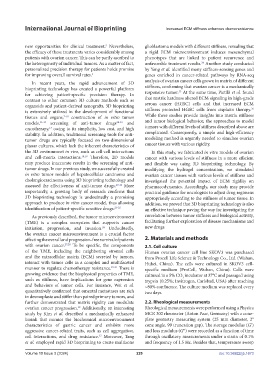Page 237 - IJB-10-3
P. 237
International Journal of Bioprinting Increased ECM stiffness enhances chemoresistance
new opportunities for clinical treatment. Nevertheless, glioblastoma models with different stiffness, revealing that
5
the efficacy of these treatments varies considerably among a rigid ECM microenvironment induces mesenchymal
patients with ovarian cancer. This can be partly ascribed to phenotypes that are linked to patient recurrence and
the heterogeneity of individual tumors. As a matter of fact, unfavorable treatment results. Another study conducted
34
personalized precision therapy for patients holds promise by Yang et al. identified many stiffness-sensing genes and
for improving overall survival rates. 6 genes enriched in cancer-related pathways by RNA-seq
In recent years, the rapid advancement of 3D analysis of ovarian cancer cells grown in matrix of different
bioprinting technology has created a powerful platform stiffness, confirming that ovarian cancer is a mechanically
35
for achieving patient-specific precision therapy. In responsive tumor. At the same time, Pietilä et al. found
contrast to other common 3D culture methods such as that matrix hardness altered ECM signaling in high-grade
organoids and patient-derived xenografts, 3D bioprinting serous cancer (HGSC) cells and that increased ECM
36
is extensively utilized in the development of functional stiffness protected HGSC cells from cisplatin therapy.
tissues and organs, 7-10 construction of in vitro tumor While these studies provide insights into matrix stiffness
models, 11-13 screening of anti-tumor drugs 14-16 and and tumor biological behavior, the approaches to model
oncotherapy, owing to its simplicity, low cost, and high tumors with different levels of stiffness described above are
17
stability. In addition, traditional screening tools for anti- complicated. Consequently, a simple and high-efficiency
tumor drugs are typically focused on two-dimensional modeling method is urgently needed to simulate ovarian
planar cultures, which lack the inherent characteristics of cancer tissues with various rigidity.
the 3D environment in vivo, such as cell-cell interactions In this study, we fabricated in vitro models of ovarian
and cell-matrix interactions. 18,19 Therefore, 2D models cancer with various levels of stiffness in a more efficient
may produce inaccurate results in the screening of anti- and flexible way using 3D bioprinting technology. By
tumor drugs. In our previous study, we successfully created modifying the hydrogel concentration, we simulated
in vitro tumor models of hepatocellular carcinoma and ovarian cancer tissues with various levels of stiffness and
cholangiocarcinoma using 3D bioprinting technology and investigated the potential impact of ECM rigidity on
assessed the effectiveness of anti-tumor drugs. 20-22 More pharmacodynamics. Accordingly, our study may provide
importantly, a growing body of research confirms that practical guidance for oncologists to adjust drug regimens
3D bioprinting technology is undoubtedly a promising appropriately according to the stiffness of tumor tissue. In
approach to produce in vitro cancer model, thus allowing addition, we proved that 3D bioprinting technology is also
identification of patient-specific sensitive drugs. 23-25 an effective technique paving the way for investigating the
As previously described, the tumor microenvironment correlation between tumor stiffness and biological activity,
(TME) is a complex ecosystem that supports cancer facilitating further exploration of disease mechanisms and
initiation, progression, and invasion. Undoubtedly, new drugs.
26
the ovarian cancer microenvironment is a crucial factor
affecting the overall and progression-free survival of patients 2. Materials and methods
with ovarian cancer. 27,28 To be specific, the components 2.1. Cell culture
of the TME, including the neighboring stromal cells Human ovarian cancer cell line SKOV3 was purchased
and the extracellular matrix (ECM) secreted by tumors, from Procell Life Science & Technology Co., Ltd. (Wuhan,
interact with tumor cells in a complex and multifaceted Hubei, China). The cells were cultured in SKOV3 cell-
manner to regulate chemotherapy resistance. 29-31 There is specific medium (ProCell, Wuhan, China). Cells were
growing evidence that the biophysical properties of TME, cultured in a 5% CO incubator at 37°C and passaged using
2
such as stiffness, have implications for gene expression trypsin (0.25%; Invitrogen, Carlsbad, USA) after reaching
and behaviors of tumor cells. For instance, Wei et al. ∼80% confluence. The culture medium was replaced every
quantitatively confirmed that omental metastases are rich two days.
in desmoplasia and stiffer than paired primary tumors, and
further demonstrated that matrix rigidity can modulate 2.2. Rheological measurements
ovarian cancer progression. Additionally, an interesting Rheological measurements were performed using a Physica
32
study by Kim et al. described a mechanically enhanced MCR 302 rheometer (Anton Paar, Germany) with a cone-
bioink that mimics the biochemical microenvironment plate geometry measuring system (25 mm diameter, 2°
characteristics of gastric cancer and exhibits more cone angle, 99 truncation gap). The storage modulus (G′)
aggressive cancer-related traits, such as cell aggregation, and loss modulus (G″) were recorded as a function of time
cell interactions, and drug resistance. Moreover, Tang through oscillatory measurements under a strain of 0.1%
33
et al. employed rapid 3D bioprinting to create multizone and frequency of 1.5 Hz. Besides that, temperature sweep
Volume 10 Issue 3 (2024) 229 doi: 10.36922/ijb.1673

